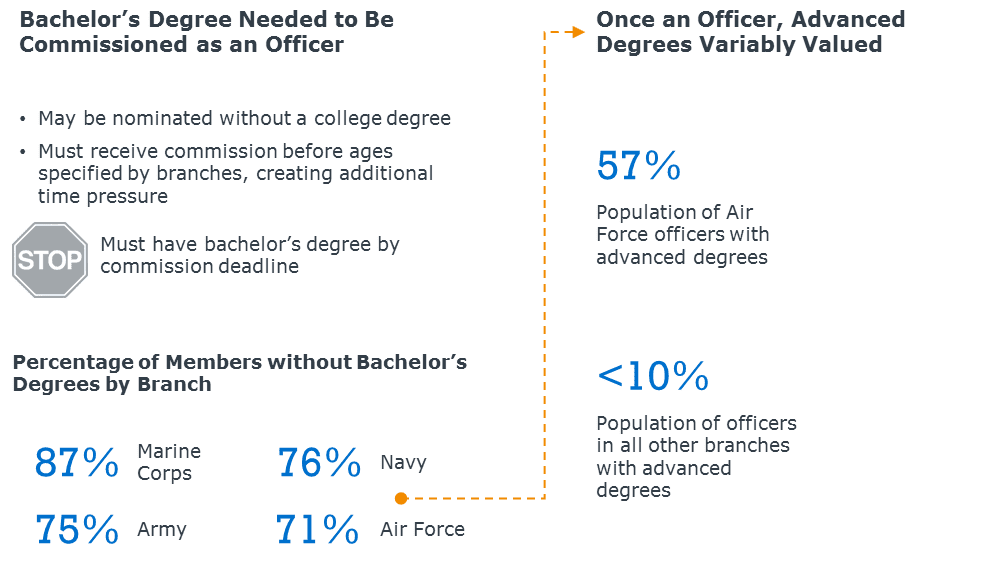At first glance, military students provide ample opportunity to achieve COE units’ ambitious enrollment goals. 91% of active duty enlisted do not yet have a college degree, for example.
But complex challenges make recruiting, enrolling, and serving these students difficult. In particular, active-duty military members serve in different branches (e.g., Air Force, Navy) at varied statuses (e.g., officer, enlisted) with distinct motivations. To recruit and serve military students, COE leaders and staff need a more realistic understanding of this group’s subpopulations and their motivations.
Military students comprise multiple, complex adult student segments
The term “military student” refers to segmented populations with diverse needs and motivations. In particular, active-duty service members and veterans provide the largest recruitment opportunity for COE units.
- Active Duty: Currently serving military students likely to use their educational benefits to advance ranks within the military. This group needs fast and flexible programs, such as ones with multiple start dates and easy course drops, due to promotion timelines and potential stop outs.
- Veterans: The largest group of military-affiliated students. Likely to use their educational benefits either to return to civilian life or advance in their civilian careers.
To recruit military students, prioritize development of bachelor’s programs. These serve the largest population as a stepping stone for students interested in using their educational benefits and advancing their military careers.
Enlisted members seeking officer promotions prioritize quick bachelor’s completion
Military service members in all branches must possess a bachelor’s degree to become an officer. Bachelor’s-level degree programs should be fast and flexible to accommodate military students’ need to earn degrees quickly.
When faced with a looming promotion deadline, military service members prioritize time to completion over other factors in program selection. Programs should also address the additional military-related challenges that could affect progress and completion, such as relocation and travel assignments, through intentional program design. For example, incorporate multiple start dates per year and create institutional policies that favor easy course drops and refunds for students who may be deployed.

Pursuing an advanced degree may not be required once officer rank is reached, but it does increase service members’ advancement potential. In particular, 57% of Air Force officers hold an advanced degree. This suggests new Air Force officers should prepare to earn an advanced degree.
For COE teams located near Air Force bases or actively recruiting students in the Air Force, modify or create programs for students to earn a master’s degree quickly.
For veterans, offer programs that align military skills to in-demand occupations
Veterans or military personnel who wish to return to civilian life prioritize programs that align with career opportunities over programs that can be completed quickly. These students seek out bachelor’s or master’s programs in topics that connect prior military experience with high demand fields as they transition to civilian life.
Due to transferrable skills that many veterans gain in the military, these students prefer programs in business and management, the health professions, and computer science and technology.
COE teams should analyze local labor market data and align program offerings to in-demand occupations that value military skills and might even prefer veterans. Many employers value budgeting, project management, personnel management, and teaching, all competencies that veterans may have gained from years of military service.